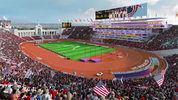which sounds great in theory. But in reality very few cities in the world have a ready made athletics stadium of 60-80k capacity. Most need to build new or adapt an existing large stadium.
Brisbane knew it didnt have a stadium suitable to host the main event. It was always going to need either a new stadium or substantial money spending making one fit for purpose.
Ironically, due to AFL, Australia is the only country in the world where you can justify building a large oval stadium for the Olympics as at least it will get used afterwards without major works needed. No other country has oval sports needing that level of stadia so they will always be either left with a white elephant or a substantial bill to turn it into a rectangular stadium for AF or soccer.
And going forward, the new norm is to be that host cities don’t necessarily need to have a gleaming, large athletics stadium.
“
Quotes attributable to IOC Vice President John Coates:
“Athletics Australia will be very pleased that with a QSAC upgrade, Queensland and Australian athletics will be left with a legacy venue for the development of the sport in Queensland.
“Sydney 2000 left a competition and warm-up track legacy for athletics, a legacy missing from the London, Rio, and Tokyo Games.
“The IOC will make available its Games construction experts to advise in respect of the potential upgrades to QSAC, including specifically whether the full $1 billion of suggested upgrades are needed.””
The IOC aren’t saying no to an upgraded QSAC and they weren’t in favour of a new stadium as it doesn’t align with their new norms.

